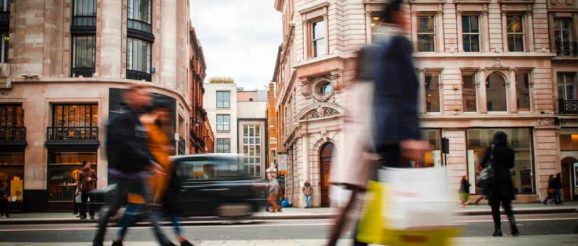In-store retail needs innovation to kickstart recovery

Despite signs of recovery beginning to show for the UK high street, Mark Leeson writes that in order to truly kickstart a post-pandemic resurgence, innovation in physical retailing is needed to attract consumers back in-store.
There was promising news for the High Street recently: overall footfall across the UK’s 63 biggest city centres in February was only seven per cent below pre-COVID levels, according to data from the Centre for Cities. Even more encouragingly, weekend footfall was back to the pre-pandemic baseline in 59 cities, and average weekly consumer spending bounced back in many city centres too.
But, as the Centre for Cities made clear, there is still a long way to go before physical retail can breathe easily. London, for example, is still the furthest away from returning to pre-pandemic levels. The data may also be skewed by the half-term break and office workers returning, rather than seasoned shoppers returning in earnest. The Easter holiday may provide some further clues.
Whether these trends persist or not, physical retail needs to continue to raise its game. It needs to attract shoppers back after two years of stop-start lockdowns and restrictions, and to counter the growth of online retail. Customers need incentives to return, and a different experience offered to that which online provides.
Providing immersive experiences needs to be the focus for recovery. Some big names are already leading the way. Nike, for example have launched boxing and yoga classes in their shops; department store Fenwick is hosting baking workshops for children; and at Selfridges shoppers can even experience psychedelic-style trips through virtual reality headsets.
If I had to predict some of the other changes that physical retail will introduce, I’d point to research for Mood Media that found 45 per cent of consumers missed the experiential in lockdown, in particular touching or trying on products. Augmented and virtual reality experiences can enhance this. Browns, the Mayfair designer store, has installed interactive mirrors in dressing rooms. These offer styling guidance and suggest complementary products to the garments being tried on; I think more stores will go down this route.
Write for us.
We’re always on the lookout for talented writers and welcome submissions. Please send your opinion piece or pitch to: [email protected]
Online and physical retail should also be seamlessly blended to complement each other. Ellis Brigham, the outdoor sports retailer, has introduced a 3D scanner in store that creates a literal digital footprint that the customer can use to size when online. In this way, in-store technology is helping tie up digital strand in a truly omnichannel experience.
I also predict smart assistants, rather than traditional store assistants, will be a growing trend. Surveys show 35 per cent of households already have at least two smart assistants like Siri or Alexa in their home and 80 per cent saying they expected to use those devices to make purchases by 2030, so it’s not too much of a leap to expect them to become regular in stores. Holograms have even been touted to replace human checkout operators. Shoppers in the Disney store, for example, could be inserting their payment card into a life-size hologram of R2-D2, mirroring the way Princess Leia uploads the Death Star plans by slotting them into the droid in the original Star Wars movie.
I also think we’ll see more stores without any checkouts at all – though these will be mainly in the convenience and essential sector, such as grocery stores. The success of Amazon Go has already led to Tesco and Aldi trialling similar checkout-free shops and I expect more to do the same.
Indeed, if Amazon – the epitome of online retail – is opening physical stores, then it shows bricks and mortar retail must have a future. Other online brands are following suit: Wow Concept, the online Spanish retailer, last week opened its first ever retail space in Madrid. The store, spanning six levels, offers a different unique experience on each floor. On the ground level, a ‘Tech Garage’ features a 3D-printed marine landscape and AR integration that blends tech with nature. The ‘Self-Care Lab’ is a relaxing, pink-coloured space designed for customers’ cosmetic requirements. Other floors are dedicated to clothing and trainers while the top floor showcases homeware alongside metaverse-inspired, VR aesthetics.
Online broadcasting giant Netflix will also open its first-ever store in Tokyo later this year; I predict a UK outlet won’t be far behind. If its reputation as a game-changing broadcaster is anything to go by, then its retail experience will be something to watch.
Exciting times could be in store. But bricks and mortar retail needs to up its game now and use the inspiration of these examples to really bounce back from the downturn and permanently turn footfall around. Otherwise it could be the end for many star names on the high street.
Sign-up for free to stay up to date with the latest political news, analysis and insight from the Comment Central team.
By entering your email address you are agreeing to Comment Central’s privacy policy
